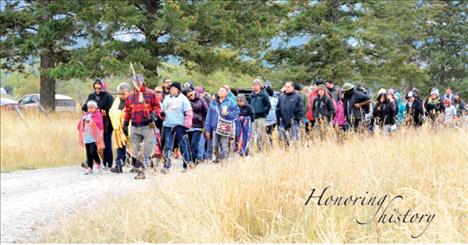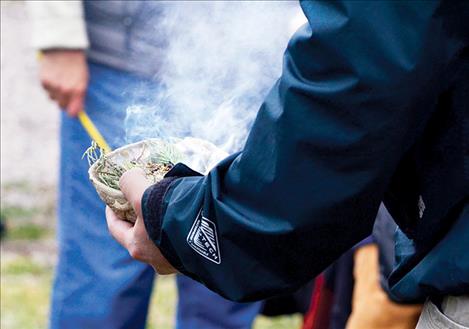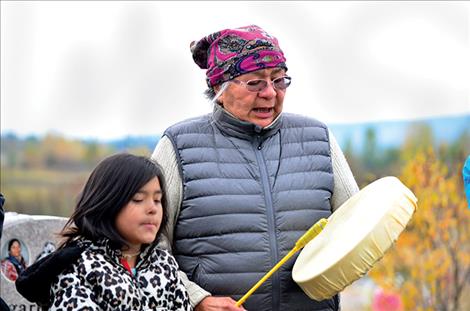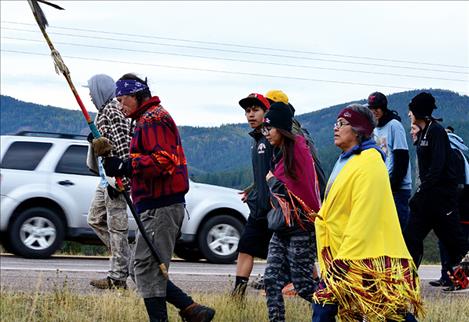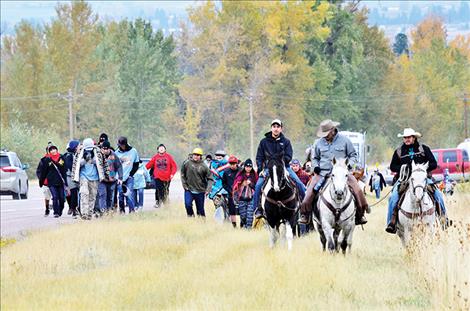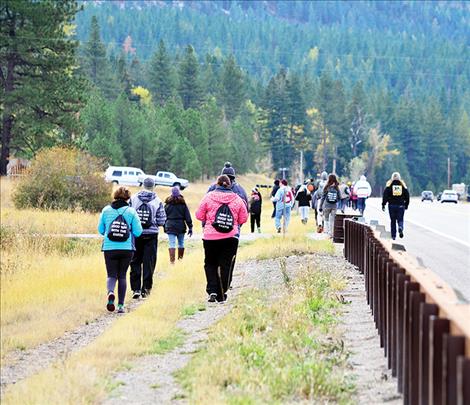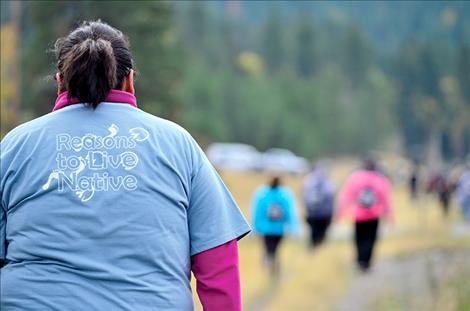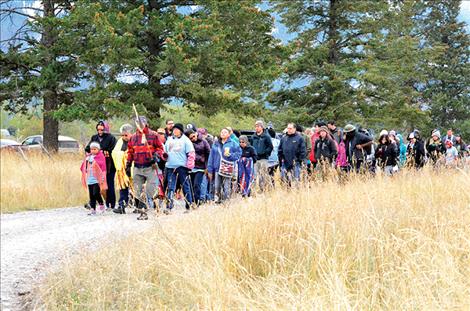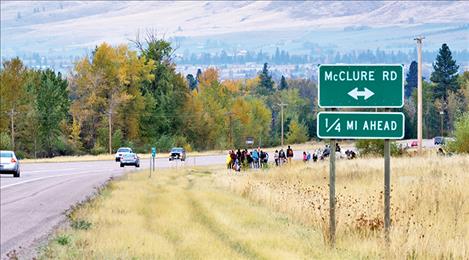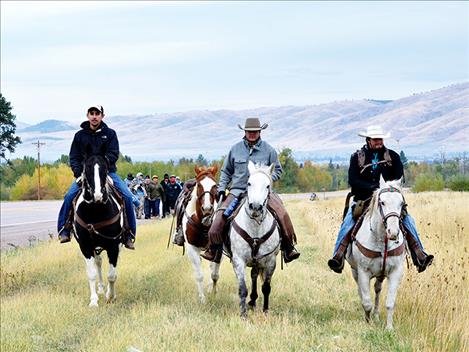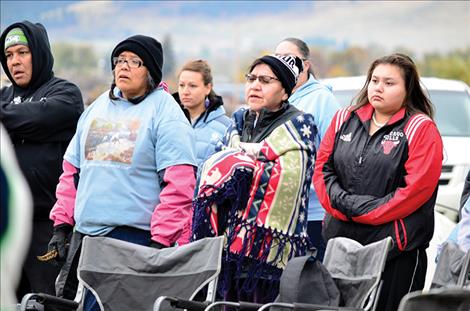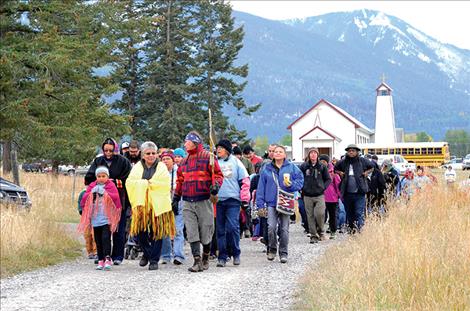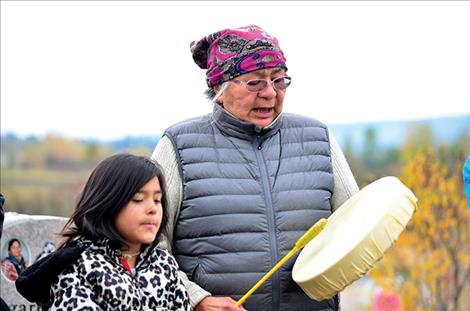Journey back to the homeland
Hey savvy news reader! Thanks for choosing local.
You are now reading
1 of 3 free articles.
Native Americans gathered at the Jocko Church to begin a journey that started 125 years ago on Oct. 15, 1891. “We do this to honor our people,” said Willie Stevens, Return to the Homeland coordinator.
The 51-mile trek followed U.S. Highway 93 from Arlee to Stevensville to backtrack over the steps the Salish and Pend d’Oreille people made as they were removed from their homelands in the Bitterroot Valley and placed on the Flathead Indian Reservation in 1891.
The three-day walk, coordinated to match the original walk as closely as possible, started on Thursday, Oct. 13, 2016, during a chilly fall morning on Agency Road. Patches of snow could be seen on the tops of the surrounding mountains, which many imagined might be similar to what it was like a century ago.
Traditional songs were shared, prayers were spoken, and a smudging ritual was performed before the walk began.
“As we walk, be proud of who you are and where you come from,” Tony Inchashola said to the crowd of more than 100 people. Incashola is the director of the Salish and Pend d’Oreille Cultural Committee.
After the walk began, MaryJane Charlo took a moment to talk about the history behind the journey. She said 125 years ago, different bands of people lived in the Bitterroot Valley including Chief Charlo and his people.
“They were the last band of the Salish to be escorted out of the Bitterroot at gunpoint,” she said.
The United States government wanted the Salish removed from the Bitterroot Valley.
“… the central purpose was to obtain legal title to most tribal lands, opening them to non-Indian settlement and concentrating the Indian people of several tribes onto a single reservation,” according to a document created for the Return to the Homeland walk.
Charlo remembers stories told by her elders about the original walk to the reservation. She said after the first day of traveling, the band camped in the Bitterroot Valley, but by the next night, they made it to the bottom of Evaro Hill and camped there.
“On the third day, they woke up and put on their best clothing,” Charlo said.
The people on horses rode onto the reservation as if leading a charge with war hoops, she said, and people previously relocated to the reservation greeted them.
“They were so happy to see relatives they hadn’t seen in a long time but they were also sad because they had left the Bitterroot,” Charlo explained.
Mary Ann Combs and Lucy Charlo-Pellow were two women that made the original walk from the Bitterroot to the reservation. Combs was noted as saying in historical documents that the walk was like a funeral march.
“They both went to the old church here,” Charlo said. “It wasn’t really that long ago. There was a deep sadness when the old people talked about the Bitterroot.”
The feelings of loss and sadness still exists, she said, but there is a sense of strength.
“No matter what the government has done to us, we are still here,” she said looking at her granddaughter, 7-yearold Lilyani Fox Howard. “We were supposed to be the vanishing Americans, but we are still here.”
Occasionally, non-Indians talk with her about the history of her ancestors saying that they didn’t personally put Native Americans on reservations so they shouldn’t be accountable. Charlo said she would like people to acknowledge that it happened instead of trying to dismiss the event.
As the trek continued onto the highway, smaller children ended their walk to avoid any problems with the cars driving past the route at 70 mph.
Arlee School District’s Native American Studies teacher Willie Wright walked part of the journey. She remembers listening to her elders as a child. Elder Sophie Moiese talked to her about life in the Bitterroot Valley. Moiese was one of the people put onto the reservation as a child in 1891.
“When I was a kid, I would go see her,” Wright said. “That’s where I ate Indian licorice. It’s like a pudding that has a licorice flavor but it’s made with lichen.”
Wright said, as she walked, she thought of the experiences Native Americans had living in the Bitterroot Valley. “With each step, I feel the heartbeat of our people,” she said. “It makes me feel strong.”
Many people said thinking about their ancestors kept them from complaining about the cold air, the rain, and the distance of the trek.
Lowrence Mahkuk, 14, walked the entire 51-mile journey as did several other people. Many people walked part of the journey. Some planned to camp for two nights along the route like the original walkers did 125 years ago.
“I want to retrace the steps of the people that did this before us,” he said, adding that the journey with modern convenience wasn’t near the struggle it was for his ancestors, but it was important to remember what they went through.















